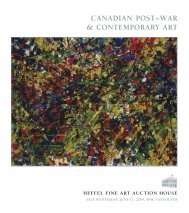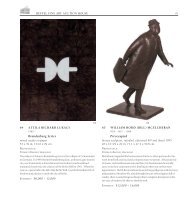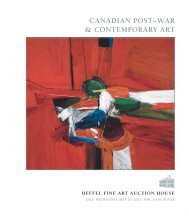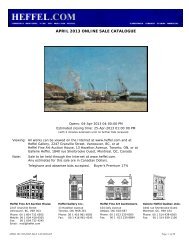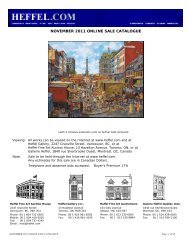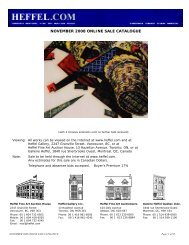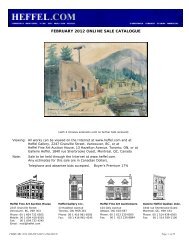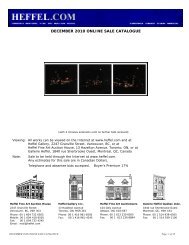CANADIAN POST~WAR & CONTEMPORARY ART - Heffel
CANADIAN POST~WAR & CONTEMPORARY ART - Heffel
CANADIAN POST~WAR & CONTEMPORARY ART - Heffel
Create successful ePaper yourself
Turn your PDF publications into a flip-book with our unique Google optimized e-Paper software.
HEFFEL FINE <strong>ART</strong> AUCTION HOUSE 17<br />
9 PAUL~ÉMILE BORDUAS<br />
CAS QMG RCA 1905 ~ 1960<br />
Ouvertures imprévues<br />
oil on canvas, signed and dated 1956<br />
and on verso titled on the Dominion Gallery label<br />
13 x 16 in, 33 x 40.6 cm<br />
PROVENANCE:<br />
Dominion Gallery, Montreal<br />
Private Collection, Ontario<br />
Ouvertures imprévues belongs to Borduas’s Parisian period of 1955 to<br />
1960. In 1956, Paul~Émile Borduas, who had not yet succeeded in<br />
making any fruitful contact with galleries or museums in Paris, received<br />
successive visits from Canadian gallery owners and collectors, who<br />
acquired most of his production of the preceding months. Max Stern of<br />
the Dominion Gallery in Montreal came in May and acquired 13 oil on<br />
canvases, among them our Ouvertures imprévues, and 11 watercolours.<br />
Soon after, Montreal collectors Gerard and Gisele Lortie visited Borduas’s<br />
studio and acquired six paintings; in July, Montreal gallery owner Agnès<br />
Lefort bought two paintings; in August, R.H. Hubbard from the National<br />
Gallery obtained the famous Sea Gull; and finally in September, Martha<br />
Jackson, the well~known New York gallery owner, acquired nine of his<br />
most recent paintings. This enabled Borduas to take a break after this<br />
intensive period of work; he bought a Simca convertible car and made a<br />
trip to Italy later in September.<br />
All these commercial activities were certainly beneficial for the painter,<br />
but create some difficulties for the historian! Paintings sold to gallery<br />
owners or to private collectors tend to disappear from sight and render<br />
the task of reconstructing the painter’s development difficult. For<br />
instance, of all the oil on canvas works acquired by Max Stern in May, only<br />
one was known until recently ~ the famous Expansion rayonnante, a black<br />
and white work from 1956, now in the collection of the Montreal<br />
Museum of Fine Arts (a gift of Dr. and Mrs. Stern in 1978). This is why the<br />
emergence of Ouvertures imprévues is so exciting. Obviously it precedes<br />
the advent of his black and white paintings, but more importantly, it<br />
shows how Borduas finally succeeded in integrating the New<br />
York~influenced watercolours that he had made two years previously.<br />
In New York, Borduas had been intrigued by Jackson Pollock’s drip<br />
technique and had tried his hand at it in some of his watercolours of 1954.<br />
But nothing of that transpired in his oils of the period. It was only in Paris<br />
two years later, as our Ouvertures imprévues clearly shows, that he found a<br />
way to integrate, if not dripping itself, at least an equivalent of it by<br />
delicate traces of the painter’s knife used on its edge here and there above<br />
the white, grey and red background. These traces of black are in fact more<br />
calligraphic, almost Japanese, than anything done by Pollock and show<br />
how Borduas succeeded in adapting his own vocabulary for what had<br />
fascinated him before. These traces of black were obviously added to a<br />
white and grey (with tiny spots of red) composition and tended to suggest<br />
a reading in depth. Perhaps this is what suggested the title of Unpredicted<br />
Openings. When these “openings” would begin to be painted in solid<br />
black instead of these subtle gradations of grey and brown, we would<br />
enter the black and white period for which Borduas is famous. Here we<br />
are just before this event in his development and it is because of this,<br />
I believe, that Ouvertures imprévues is so touching. It is a perfectly<br />
controlled composition, alternating vertical and horizontal strokes of<br />
white and grey that come from the four edges of the surface towards the<br />
centre, where most of the “openings” occur. This is Borduas at his best.<br />
In Paris he spoke of his admiration for Mondrian, and something of that<br />
regard is shown in this rigorous composition. But the spontaneity and the<br />
obvious speed and mastery of the handling of paint make us forget<br />
whatever influences may have played here, and we are delighted with the<br />
sheer beauty of the painting.<br />
We thank François~Marc Gagnon of the Gail and Stephen A. Jarislowsky<br />
Institute of Studies in Canadian Art, Concordia University, for<br />
contributing the above essay.<br />
ESTIMATE: $80,000 ~ 100,000



